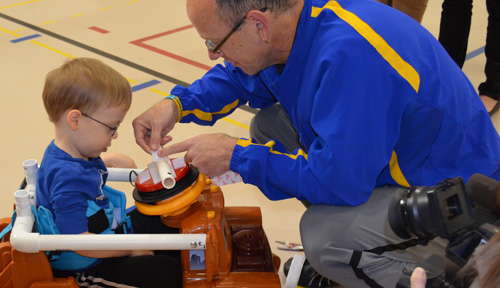The idea to modify cars is not new. Just look at reality shows like “Trick My Truck.”
But the concept of adapting toy cars for children with disabilities? Now, that’s novel.
That’s exactly what happened at UNMC’s Center for Healthy Living this spring. Fifty area physical therapists broke out the power tools and listened to national early mobility expert Cole Galloway, Ph.D., from the University of Delaware, teach them how to turn “Power Wheels” into early versions of power wheelchairs.
First, they ripped off the steering wheels of six toy trucks and attached big red buttons in their place. Then, they added kill switches by drilling holes into the plastic near the license plates. Next, they added padded PVC pipe frames and finally, seatbelts. Last but not least, decal stickers made the Larry the Cable Guy character car come to life.
The cost: $89 for each car, plus supplies.
The cost for a power wheelchair: somewhere in the neighborhood of $5,000 to $20,000.
“Most adaptive equipment is considered medical equipment, therefore they don’t sell very many and it drives up the cost,” said
Reggie Harbourne, Ph.D., associate professor of physical therapy at UNMC’s Munroe-Meyer Institute and organizer of the workshop. “This is so easy, what do we have to lose?”
Physical therapists spent about an hour transforming the toy cars. Finally, the big moment: putting kids behind the wheel for a test drive.
First up was 3-year-old Tyler Lundy, who has cerebral palsy. Much like a 16-year-old trying to operate a stick shift, his driving was herky-jerky at best. After a few tries, he put the red button to the floor and cruised around the gym at three miles per hour. Just when his parents saw their son growing up before their eyes, the car stopped abruptly. Tyler was crying. He couldn’t see his mom anymore.
“They do tend to cry the first couple times,” Dr. Harbourne said. “It’s a lot of new information. The noise, the speed, and for some it may be the first time they’ve ever caused something to go.”
Next up was Brandon. At just 11 months, he was the smallest of the children to try out the truck. Born prematurely, he is still learning to roll over. While an initial smile crossed his lips when he hit the gas, it wasn’t long before he, too, was in tears.
His face said it all: “Where’s my mom?”
The access to mobility for children who can’t move on their own is beneficial in two ways, Dr. Harbourne said. It allows them to control their environment and to socialize.
Just like adults who get something new and want to show it off to their friends, kids clamor to get close to TowMater or Mater, as he’s known in the movie.
“Other kids Tyler’s age normally don’t want his toy; nobody wants a stroller. But with this, they’ll come talk to him, and he can work on his social and language skills, too,” Dr. Harbourne said.
Without mobility, kids with disabilities don’t have much of a chance to create cause and effect, which helps them understand concepts like over, under, around and through.
“If children don’t have the motor capacity to do things they cause the effect of, it can lead to delays in others area, like cognition or language. They don’t learn by watching others do things,” Dr. Harbourne said.
Tyler got the “cause and effect” message loud and clear. His parents were excited for him to take the car home.
“This is a great way for him to keep up with his peers,” said his mom, Jennifer. “Just like any typical boy…he loves to go fast.”
